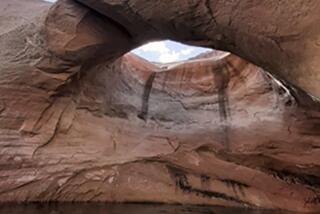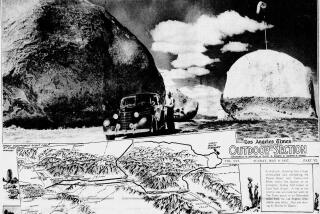Monolith Vanishes Mysteriously, as It Arrived
- Share via
SEATTLE — Dawn of the new year, 2001: A mysterious steel monolith appears on a windswept hilltop in a public park. Its orientation is the line between sunrise and sunset. Its dimensions: 1 foot by 4 feet by 9 feet--the square of the first three prime numbers.
Then, as suddenly and inexplicably as it appeared, the monolith vanishes.
In its place Wednesday morning at Seattle’s Warren Magnuson Park was a single, broken red rose--and dozens of people who, mindful of the enigmatic monolith in the film “2001: A Space Odyssey,” had come looking.
“I don’t know what happened. Someone might have taken it. Or . . . or . . . What more can I say?” Park Director C. David Hughbanks wondered aloud. “It’s all very mysterious.”
Since New Year’s Eve, when workers opened the park’s locked gates to find the monolith standing on a hill, it has been the talk of Seattle. Hundreds of people have made their way up the hill to stand--contemplating it, softly touching it or sharing stories of the 1968 Stanley Kubrick film and Arthur C. Clarke novel that must have inspired it.
In the film, the monolith is a godlike force--perhaps dispatched by a superior race of aliens--that appears as a spiritual, almost evolutionary, sentinel. It presides over the transition of an ape to a tool-wielding man, from a man to a universal star-child. It makes its modern-day debut on the moon, in the unimaginably futuristic year of 2001.
Seattle’s monolith gave no clues as to its own origins. The park gates had been locked for the night Saturday, although there was access to the site from a boat ramp on Lake Washington. It would likely have taken six to eight men to haul the hollow steel edifice up the hill, Hughbanks said.
“It was absolutely perfectly set in the ground,” he said. “You could not detect any wheel marks, the grass was right up beside it sort of growing, and not cut. And here this thing just sat.”
Within hours, word spread on local television and on science fiction Internet sites across the country. For three days, visitors were drawn to the monolith.
“Everybody had to touch it. It reminded me of the movie, where all the apes were kind of reaching out,” said Jack Boyer, a retired police officer who likes to fly kites on the normally bare hill. “It obviously means a lot to a lot of people.”
Park officials were planning to test the stability of the structure Wednesday morning. But when they got to work, it was gone as suddenly and silently as it had appeared. A concrete pad that apparently had anchored it was still there. So was some melted candle wax in the grass, and the broken rose.
Hughbanks figures the monolith was part of Seattle’s long history of guerrilla art.
In 1993, a group of industrial artists known as Fabricators of the Attachments hooked a huge steel ball and shackles to the leg of the Seattle Art Museum’s famous Hammering Man sculpture. In 1996, artist Jason Sprinkle left an 1,800-pound metal heart in the back of a pickup marked with the word “bomb”--bringing the downtown area to a temporary standstill.
But Fabricators spokeswoman Virginia Rose said the usual suspects had nothing to do with the monolith. “We didn’t do it,” she said. “I wish we did. It’s very cool.”
On Wednesday, dozens of people were still filing up on the hill, around the empty pad.
“People are coming because of the year. When the movie came out, it seemed so far away,” said Richard Miske, 28.
“I’m not quite old enough to have seen ‘2001’ when it first came out,” said Dana Wilcox, a 40-year-old supermarket manager. “But I saw it when I was quite young, and it made a big impression.”
So Wilcox added his own statement Tuesday, pasting a couple of “Go Huskies” banners on the monolith in honor of the University of Washington’s Rose Bowl win.
But when he came back Wednesday, the monolith--and the Huskies banners--were gone. Wilcox was nonplused. “I hope I didn’t offend the creator.”
More than likely, others said, its disappearance was part of the point. Sudden spiritual enlightenment isn’t the kind of thing that hangs around, gets rained on, has to have the grass cut around it.
More to Read
The biggest entertainment stories
Get our big stories about Hollywood, film, television, music, arts, culture and more right in your inbox as soon as they publish.
You may occasionally receive promotional content from the Los Angeles Times.










